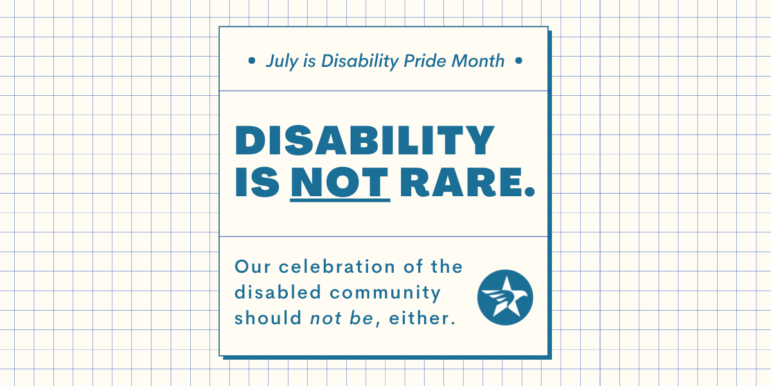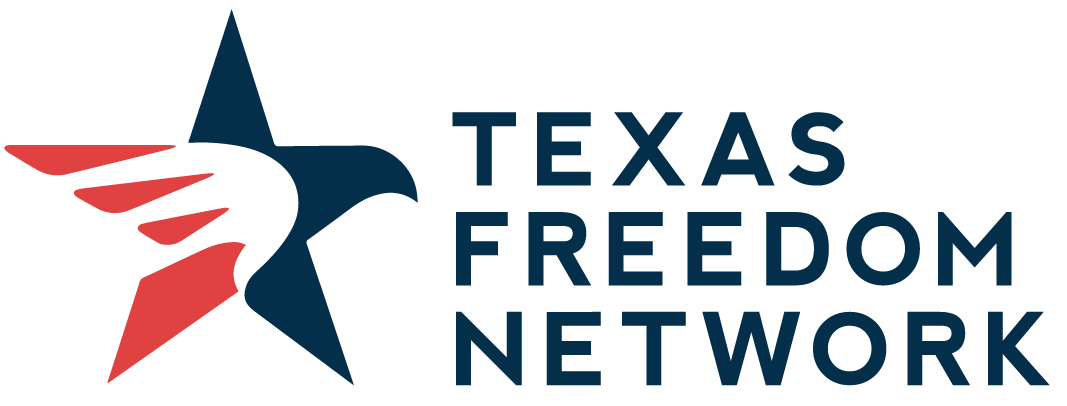This Disability Pride Month, we’re called to move through the world using a lens that is inclusive and honoring of everyone. Further than that — we have a responsibility to become part of the change needed to create a world where disability pride is uplifted every single day.
Our culture is not built with disability in mind, and that construction goes far beyond a lack of accessible buildings and public spaces.
Why is this the case when living with a disability is not rare, and any one of us could become part of the community at any time? 1 in 5 American adults are living with a disability, and 1 in 4 Texans live with a disability. It’s been time for our society to collectively celebrate, recognize, and show gratitude for the diversity that’s added to our world by people who have disabilities–seen and unseen. Especially during an ongoing pandemic where so many in the disability community feel their lives have been devalued and their safety has been sacrificed so that non-disabled people can enjoy the outside world as they choose.
This Disability Pride Month, we’re called to move through the world using a lens that is inclusive and honoring of everyone. Further than that — we have a responsibility to become part of the change needed to create a world where disability pride is uplifted every single day.
July is designated as Disability Pride Month because it marks the passage of the Americans With Disabilities Act on July 26, 1990. That same year, the first Disability Pride Day was held in Boston, and Disability Pride Month was established. Although the month has yet to be officially recognized by the federal government — it’s still a carved-out space for the disability community to publicly affirm their dignity, advocate for representation, and build awareness for the needed changes in communities and institutions for true equity — from the workplace to the grocery store.
Pay attention and listen. Ask yourself — is that ableist?
Our environment is steeped in ableism. It’s so baked into our culture, that even people who’ve lived with disabilities their entire lives can miss all of the ways that ableism is pervasive.
“The word ‘ableist’ was definitely not one I heard as a kid. And while today I have as much disability pride and blind pride as anyone I know, I get stuck sometimes on the ableist language.”
M. Leona Godin, a blind scholar and author
“The word ‘ableist’ was definitely not one I heard as a kid. And while today I have as much disability pride and blind pride as anyone I know, I get stuck sometimes on the ableist language — and humor — that I grew up with as a Gen Xer,” M. Leona Godin, a blind scholar and author, writes in the New York Times.
The first thing you can do to be more inclusive is to ask the question: “Is that ableist?” The second thing you can do is to be open to the answer — whether you find it through self-reflection or someone letting you know that your words, actions, or behavior have caused harm.
A key and constant way that ableism shows up in our everyday lives is through language. Common phrases like “stand up, stand for,” etc. can be difficult habits to break, but eliminating those phrases from our vocabulary can go a long way in acknowledging everyone — particularly when we’re working and organizing within social justice movements meant to benefit all of us.
We can also say what we mean instead of attacking a marginalized group with our speech by using words like “shocking” or “outrageous” instead of stigmatizing terms like “crazy” or “psychopath.”
Using person-first language might be the preference for some folks, like “person with a developmental disability” vs. “developmentally disabled person.” However, the way a community prefers language to be used can vary based on individual preference and our evolution in understanding. For example, for decades, person-first language was widely used within the autistic community, but now, we’ve seen a shift, and many autistic people and advocates have expressed a desire to center identity-first language. Meaning, that you’d say “autistic person” instead of “person with autism.”
Part of inclusivity is being open to these changes and committing to continued learning.
Disability is all around us — and we have to de-stigmatize the term.
Ableism and stereotypes about people with disabilities have caused us to think we can recognize disabilities–but many disabilities, like bipolar disorder or chronic pain, might be unseen. And many people may feel alone in their disabilities because we’ve been conditioned to think it’s a deficit. Kathleen R. Bogart, a professor and scholar with a non-stereotypical disability, outlines why this is.
“Disability is not a bad thing. It just is. It’s a common form of human variation, like hair color. [To identify with a disability] can also be a source of community and pride.”
Kathleen R. Bogart, PhD
“People like me with non-stereotypical disabilities seem less likely to identify with the term ‘disability.’ A major reason is that the term disability is mired in stigma; we think of it as a ‘bad word.’ To identify with disability in most cultures means to be limited or weak. That’s why a common but misguided compliment is: ‘I don’t think of you as disabled.’ Disability is not a bad thing. It just is. It’s a common form of human variation, like hair color,” she says. “[To identify with a disability] can also be a source of community and pride,” Bogart adds.
Why does this month celebrate pride — doesn’t Pride Month already exist?
While disability pride and parades may be relatively new to some of us, at its core, the concept is not dissimilar to other pride movements in our culture.
“Disability Pride, much like LGBTQIA+ Pride, is all about celebrating and reclaiming our visibility in public because people with disabilities have historically been pushed out of public spaces.”
Laken Brooks, a graduate student at the University of Florida
“Disability Pride is an event that celebrates people with disabilities and chronic illnesses. Now, some people may balk at that second word, Pride. But Disability Pride isn’t about appropriating LGBTQIA+ Pride. In fact, the disabled and the LGBTQIA+ communities have long been intertwined and have long survived under similar systems of oppression. Disability Pride, much like LGBTQIA+ Pride, is all about celebrating and reclaiming our visibility in public because people with disabilities have historically been pushed out of public spaces,” says Laken Brooks, a graduate student at the University of Florida, writer, and digital storyteller.
Pride movements are built to combat the stigmatization and marginalization of communities who are simply existing and deserve to thrive in visibility. Disability Pride is just that: Refusing to be erased by the dominant culture and being unapologetically seen.
This Disability Pride Month — we’re reflecting on what facets of our own language and lives are upholding ableism, how we can find and display pride in our own disabilities, and working to dismantle the stigmatization of disability in our work and world. We hope you’ll join us.


